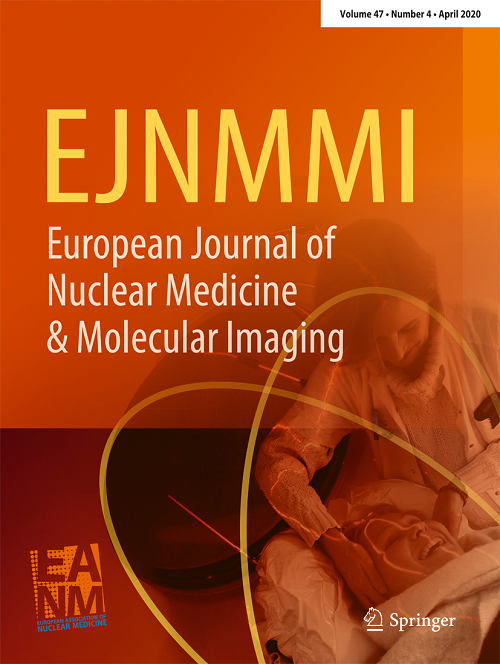Head to head comparison of [18F]SiTATE versus [18F]DOPA-PET in patients with neuroendocrine tumors.
IF 7.6
1区 医学
Q1 RADIOLOGY, NUCLEAR MEDICINE & MEDICAL IMAGING
European Journal of Nuclear Medicine and Molecular Imaging
Pub Date : 2025-09-26
DOI:10.1007/s00259-025-07572-w
引用次数: 0
Abstract
BACKGROUND In neuroendocrine tumors molecular imaging methods play a key role, either targeting the somatostatin receptor or catecholamine pathways. [18F]SiTATE is a somatostatin receptor-targeting peptide that uses silicon fluoride acceptor (SiFA) radiochemistry, overcoming disadvantages of Gallium-68 labelled DOTA compounds. Here we present the first prospective data of [18F]SiTATE compared to [18F]DOPA-PET in NET patients. METHODS 38 patients with suspected neuroendocrine tumors were prospectively included. All patients underwent both [18F]DOPA-PET and [18F]SiTATE-PET. The diagnostic performances were compared on a per-patient and per-lesion basis. RESULTS 22 of 38 patients did not show [18F]DOPA- or [18F]SiTATE-PET positive disease. [18F]DOPA-PET was rated as the more accurate imaging modality in three cases and [18F]SiTATE-PET in four cases. [18F]SiTATE-PET showed a significantly higher sensitivity on a per lesion basis compared to [18F]DOPA-PET (n = 143; sensitivity [18F]SiTATE: 86.7%; [18F]DOPA: 73.4%; p = 0.016). Relative quantitative uptake values were not significantly different ([18F]SiTATE median Tumor to Background Ratio max (TBRmax): 8.2; [18F]DOPA TBRmax: 6.5; p = 0.247). CONCLUSIONS In this first prospective study, [18F]SiTATE-PET provided high tumor to background ratios in the majority of NET patients with complementary results to [18F]DOPA-PET.[18F]SiTATE与[18F]DOPA-PET在神经内分泌肿瘤患者中的头对头比较
在神经内分泌肿瘤中,分子成像方法发挥着关键作用,无论是针对生长抑素受体还是儿茶酚胺途径。[18F]SiTATE是一种生长抑素受体靶向肽,利用氟化硅受体(SiFA)放射化学,克服了镓-68标记的DOTA化合物的缺点。在这里,我们首次提出了[18F]SiTATE与[18F]DOPA-PET在NET患者中的前瞻性数据。方法前瞻性纳入38例疑似神经内分泌肿瘤患者。所有患者均行[18F]DOPA-PET和[18F]SiTATE-PET检查。诊断性能在每个病人和每个病变的基础上进行比较。结果38例患者中22例未出现[18F]DOPA-或[18F]SiTATE-PET阳性疾病。[18F] 3例DOPA-PET被评为更准确的成像方式,[18F] 4例SiTATE-PET被评为更准确的成像方式。[18F]与[18F]DOPA- pet相比,[18F]SiTATE- pet对每个病灶的敏感性明显更高(n = 143;敏感性[18F]SiTATE: 86.7%; [18F]DOPA: 73.4%; p = 0.016)。相对定量摄取值无显著差异([18F]SiTATE中位肿瘤与背景比max (TBRmax): 8.2;[18F]DOPA TBRmax: 6.5;p = 0.247)。在第一项前瞻性研究中,[18F]SiTATE-PET在大多数NET患者中提供了高的肿瘤与背景比,与[18F]DOPA-PET结果互补。
本文章由计算机程序翻译,如有差异,请以英文原文为准。
求助全文
约1分钟内获得全文
求助全文
来源期刊
CiteScore
15.60
自引率
9.90%
发文量
392
审稿时长
3 months
期刊介绍:
The European Journal of Nuclear Medicine and Molecular Imaging serves as a platform for the exchange of clinical and scientific information within nuclear medicine and related professions. It welcomes international submissions from professionals involved in the functional, metabolic, and molecular investigation of diseases. The journal's coverage spans physics, dosimetry, radiation biology, radiochemistry, and pharmacy, providing high-quality peer review by experts in the field. Known for highly cited and downloaded articles, it ensures global visibility for research work and is part of the EJNMMI journal family.

 求助内容:
求助内容: 应助结果提醒方式:
应助结果提醒方式:


